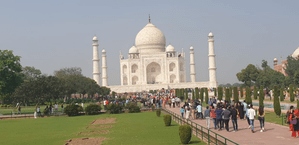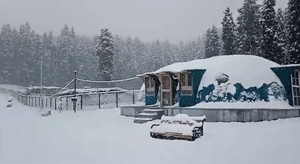
Tourists who visit the 17th century monument of love, the Taj Mahal in Agra, rarely fail to ask if the world heritage monument has finally become safe from the dangers of air and water pollution.
Is the Taj Mahal sinking? Is the colour of the mausoleum turning yellow or grey?
The answer to all these questions and fears is both yes and no. When the SC pronounced its judgment in a series of directives while disposing of the PIL of eco lawyer MC Mehta, between 1993 and 1997, there was an international alarm over the conservational flaws and threats from environmental degradation in Agra.
The apex court on the recommendations of the high-powered committee headed by scientist S Vardarajan shut down all polluting industries in the Taj Trapezium Zone, spread over 10,400 sq km, ordered the laying of a natural gas pipeline, asked the Mathura Oil Refinery to set up hydrocarbon cracker unit and use low sulphur crude, directed the UP government to ensure uninterrupted power supply to discourage the use of diesel generators.
It also asked the UP Forest department to intensify greening efforts to insulate the Taj Mahal from air pollution. The SC also ordered the construction of a barrage or weir downstream of the Taj Mahal on the Yamuna River.
Over the past two decades, the Archaeological Survey of India (ASI) has undertaken a series of measures to protect the Taj Mahal and other monuments in Agra from pollution.
Frequent mud therapy using Fullers Earth has removed dirt stains from the surface. The Taj looks cleaner and healthier, most tourists say. The Agra Municipal Corporation, presently headed by a young official Ankit Khandelwal, continuously ensures that the areas outside the Taj remain clean and attractive. The security agencies both inside and outside have modern types of equipment to deal with any situation.
The UP Police have introduced innovative crowd management techniques, leading to a hassle-free experience for the visitors.
Undoubtedly, some of the measures have yielded encouraging results. “The Taj looks as sparkling and cleaner than it did when I visited it with my family in 1994,” said an elderly visitor from Maharashtra.
First-time foreign visitors feel mesmerised and express their awe at the sight of the monument bathed in the soft wintry sunlight.
“Yes, it looks dazzling and emits youthful romantic vibes,” said a female visitor from Italy. She had heard a lot about pollution and the toll it had taken on the mausoleum. But she agreed that it did not look fatigued or worn out.
“Surely, a masterpiece, a divine architectural model,” her companion added.
Agra’s Taj Mahal continues to draw hordes of tourists from all over the world. As the winter vacations have started the number of daily visitors has gone up to 50,000.
“It’s kind of love at first sight. The Taj simply hypnotises you when you first see a glimpse from the main forecourt. As you move closer to the main structure, the size and scale, the grandeur, and the magnificence of the mausoleum overpowers you. It’s beautiful beyond words,” said a tourist from Karnataka, leading a group.
Like the sentiment of love, the romance with the Taj Mahal will never fade or age.
“You talk to any visitor, the reactions are generally positive and kind of catharctic, a memorable experience it always is. As some leaders said long back, the world is divided into two segments, one those who had seen the Taj and the unlucky ones who had not,” said tourist guide Ved Gautam.
Hassles like logistics, conning by touts, and long wait apart, once a tourist has seen the Taj Mahal, he forgets the negatives and returns with pride and joy.
“And who is not touched by a love story that gave the world such a precious monument,” asks a small hotel owner of the Taj Ganj area.
Though people in Agra generally feel that the Yogi government in UP has been biased against the city and its monuments, the reality is that a series of measures taken over the years have eased mobility, offering multiple choices of stay and cuisine, more attractions in the city, and comparatively cleaner surroundings.
The railway stations have become user-friendly, and air connectivity with half a dozen cities and the availability of electric buses, and CNG-run autos have all helped tourism growth in Agra.
Work on the Agra Metro rail project is progressing fast and will surely help bring down the pollution level in the coming years. Visitors say that the safety apparatus around the Taj Mahal is efficient and sensitive to the needs of the tourists.
After recent tragic events at the Taj Mahal, involving tourists, the state government has stationed ambulances and basic facilities, along with the quick response teams.
On the negative side, are problems that need to be addressed by the Central government. One relates to the dry and polluted Yamuna river which is quite a put-off.
“When the tourists see the Yamuna at the rear the reactions are not pleasant. Fresh water should be discharged from upstream barrages and steps taken to begin construction of the dam downstream of the Taj Mahal,” says Mukul Pandya, a passionate horticulturist of the city.
“The ugly and stinking Yamuna is a grim reminder that the reality hasn’t changed much, though a thousand crores of rupees have been squandered away on fancy promises,” says Padmini Iyer of the River Connect Campaign.
Green and Red insects or mysterious microbes have made permanent breeding grounds towards the riverside at several spots on the main structure. Environmentalists have identified dry Yamuna as the source of these polluting organisms, Iyer added.











